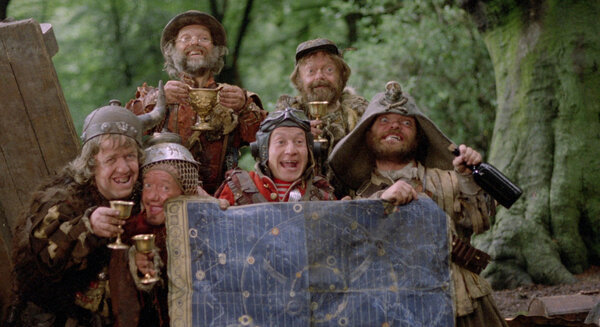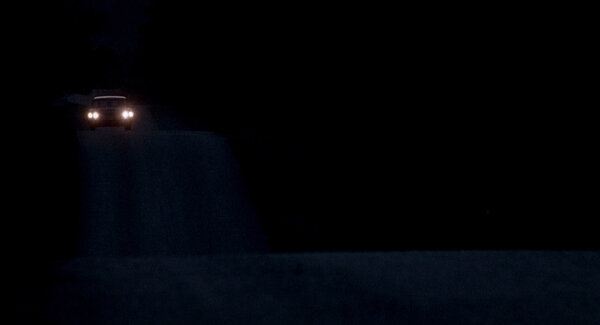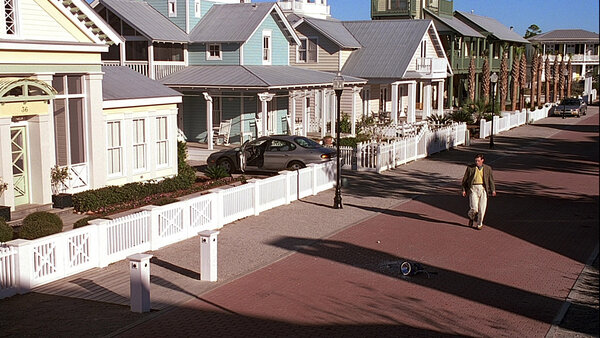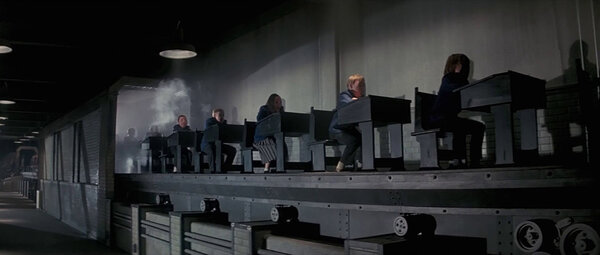Looking back on the meeting and discussion with Peter Biziou, BSC
By Margot Cavret for the AFCBefore he began showing the clips that punctuated the conference, Peter Biziou wished to share his credo – the main principle that had guided him throughout his prolific career. “The main thing is to learn how to use your tools, to practice a lot, to become skilled, to exactly know your possibilities, and not allow anyone to force choices on you. You have to work hard and with passion so that you can be able to easily and quickly adapt to changes and unforeseen events and be able to accompany the director and the actors flexibly.”
The first stop on this chronological journy was Bandits, Bandits (1981). On this film, Peter Biziou once again worked with Terry Gilliam, two years after The Life of Brian. “He has a wonderful imagination and when you work with him, you enter another world. In the first version of the screenplay he sent me, the characters were portrayed in nine different time periods, and I first turned the film down because I thought that it couldn’t be done in 12 weeks of shooting. We discussed it, and he agreed to cut it down to 5. Between his hands, anything can be brought to fruition. He is a skilled draughtsman, and he made a stick-figure storyboard during preproduction along with a nice drawing of the set, which gave us an idea of scale. On his drawing, I was able to begin to place the lighting.” He said that sometimes the set design crew pulled all-nighters to perfect the set according to the director’s vision. “Strangely, it didn’t affect pre-light that much. I always prepare the lighting for the wide shots and then I adjust it for the close-ups. I am a perfectionist but I’m not obsessional : while I always try to give my best, I also try to never cross the limit of doing something that would endanger the production. I am pleased with this film, because I know I did as well as I could.”

The second clip was from Mississippi Burning (Alan Parker, 1988), a film that earned Peter Biziou an Oscar for Best Cinematography. “Alan Parker is a difficult director, who is very knowledgeable about technology. This is the type of person you have to really know your stuff with, you have to be able to defend your choices, find a way to make suggestions, and remain confident. He was very insistent about shooting in Jackson, Mississippi. This is a flat region, and we had to find a way to make it look dramatic. I would begin with a natural gaze and then I would amplify it in a certain direction depending on the emotion. If it was tragic, I’d increase contrast ; if it was happy, I’d increase the light levels, etc. This allowed me to mix emotion with realism. Although the film was shot nearly forty years ago, the audience was curious and asked precise questions about certain scenes. Peter Biziou mobilized his memories in order to be as precise as possible in his answers. “For the night scene where you see cars driving along the lake, as soon as we did the location scouting, I knew I wanted smoke, like mist coming off of the lake. That meant we had to have directive lighting. I put a spotlight on a crane. That was a real gamble because if Parker decided to shoot from a different angle, we would have had to redo the entire setup.”

“I reread the screenplay several times, as usual, to attempt to get two specific looks out of it, both night and day, that I try to maintain throughout the film. This also enables you to allow the gaffer to work autonomously because he knows what type of light he is supposed to create throughout shooting. We reused the spotlight on the crane several times for night scenes, and always placed it as high as possible above the set, so that we could light the maximum area with just that spot. For the burning church scene, we put the crane on top of a hill so that we could guarantee a minimum level of exposure before the flames took over.”
About the night scenes, an audience member asked Peter Biziou how he would light the film if it had to be remade today. “It would definitely be easier with a digital camera and sensor. I would definitely replace the crane with an Airstar balloon. All of the equipment would be lighter and easier to use, but I wouldn’t change my overall approach.”

The conference continued with the screening of clips from Richard III (Richard Loncraine, 1995). “This was a wonderful experience. It was truly a joy to work with this director who was so aware of the possibilities that technology provided him, and to work with Ian McKellen, the main actor and co-screenwriter who had a great knowledge of Shakespeare’s plays. Together, we designed the film, its anchoring in the 1930s, the reference to Nazism, and the very theatrical aspect. My role was to make the gaze dramatic, to make it cold and hard, without fearing theatricality because that was what we were after.”

The last clip to be played was from The Truman Show (Peter Weir, 1998). “When I received the screenplay, I immediately fell in love with it. It was intelligent and I was very intrigued because the whole idea of the film would allow us to shoot from angles that had never been seen before. We would make little mock-ups in front of the camera to create all the little hidden cameras that didn’t exist at the time but that we invented !”
Unlike what one might think, a large portion of the film was shot on location. “Peter Weir’s wife had heard about Seaview, a development where all the houses were identical, and that was exactly the location we were after. It did present some difficulties, because all the houses were white, and the very blue sky filled the shadows with cool dominant colors. I used reflectors to fill the shadows with reflections of the sun.” The crew also had to face the challenge of demanding special effects, almost all of which were done on set. “For the storm scene, we shot in Universal Studios, in an enormous basin of water. It had a wave machine, and this scene was technically very difficult to shoot. Because the main idea of the film is that Truman’s world was fake, there is a scene where the director of the television show orders a sunrise. That would have cost a fortune to do in postproduction, so my super grip crew successfully created a sun on a bar that we could rise in real time to create the effect on set.”

Of course, the audience was interested in the strong personality of the starring actor, Jim Carrey, and Peter Biziou replied with a great deal of fondness. “He is a very talented actor, he spends his time studying the people around him, and trying to imitate them, and that’s how he comes up with all of his imitations. I would always wear a baseball cap on set, and one morning he showed up with the same cap as me ! It was hard for Peter to direct such a talented and extravagant actor. At the beginning, he couldn’t figure out how to erase Jim Carrey so that Truman could exist. It was very funny, but it wasn’t the right character. He took the time to show Jim Carrey the dailies who understood the problem on his own.”

The conference ended with an open Q&A session with the audience. Peter Biziou was asked about the way he chose projects and prepared for them. “I have to feel the script is calling to me, I have to meet the director with a vision to propose to him, and I have to be able to convince him I can bring something to the film. Then, I always remain open to the director’s desires and I ask for rehearsals, if possible, to understand what direction we are to go in. For In the Name of the Father, I had a local cameraman, who was very skilled, but who would begin to block the ground the minute he arrived on set. I asked him to stop because it wasn’t up to us to decide where the actors should stand ; we have to wait to see how they will move on set, and the story has to tell us what to do. Each film guides the treatment we apply to it on its own.”
He was also asked to give his opinion on current-day cinematography, and what the profession has become. “I have always shot on film, even my last films, where it was possible to shoot in digital. It was still the early days of digital and the images were too precise, too brutal, and I couldn’t at all feel the organic quality of film. Today, things are changing. There are a lot of new technologies, but there are a lot of new cinematographers who know how to sue them. Of course, these technologies sometimes enable laziness, but they also offer lots of possibilities, and I see a lot of very talented cinematographers taking advantage of that. Things are changing for everyone involved in filmmaking, not just for cinematographers. Now that we can shoot with much larger apertures without damaging the image, things are becoming harder for the first assistant camera. I was an assistant for a great many years and at that time, the cinematographer would always ask me what depth of field I needed. Now, it’s the opposite, and the assistant camera has to adapt on his own, which is very hard ! As a cinematographer, I sometimes shot with wide apertures but I would always discuss it with the cameraman and I would tell the director if the take hadn’t come out well and I would ask him for another one. I knew that of six takes, only one might be good and I would take full responsibility to protect my crew.”

The next day, Peter Biziou, alongside Bob Geldorf, musician and lead actor, presented the film Pink Floyd : The Wall. Bob Geldorf discussed his first (and according to him, disastrous) performance as an actor with a great deal of humor. He also paid tribute to Peter Biziou. “I was much more interested in the technical side of things and I came to understand that that worked a bit like in a rock band : the director is the composer, and he is trying to coordinate all of his musicians, all of his teammates, to get the film he wants, like a song. The actor is the musical instrument. And the cinematographer is the sound engineer. The sound engineer makes sure the music being played by the band is correctly received by the audience so that they can enjoy it. This is exactly what the cinematographer does, he’s the one who makes the film real, concrete, so that he can deliver it to the viewers. I hated the film for a long time, but when I watched it again this evening, I began to realize why people like it so much. It is totally open to interpretation. In the end, it’s also very close to music because what I like in music is that it doesn’t dictate anything, your imagination remains free. I understand that The Wall speaks to people, but in a different way, depending on their experience. That’s what makes the film powerful. That is why I am happy I was able to be a part of this project.”

(Transcribed by Margot Cavret for the AFC, and translated from French by A. Baron-Raiffe)
 En
En Fr
Fr





